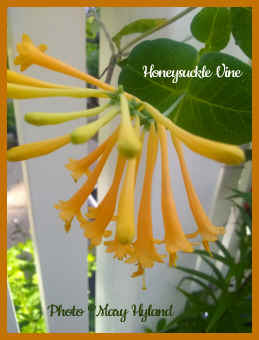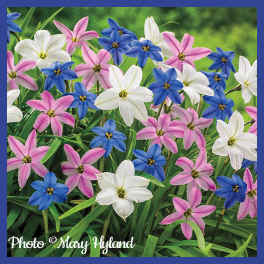 |
 |
To download a free copy this
hummingbird garden design page in .pdf format,
click here, and save to a folder on your computer.
|
About the flowers Choose flower colors to suit your tastes. Brighter colors attract the attention of the birds, but they'll follow the sweet scents of any color flowers. Most of the hummingbird's favorite flowers have tubular-shaped blooms to poke their long beaks into, and very sweet fragrances. You get not only blooms and hummers each day, but aromatherapy, as well. These flowers attract other beneficial pollinators to the garden. Choose plants that produce nectar, and bloom together or in close succession to attract these little birds all season. They'll eat destructive insects, as well.
Bee Balm (Monarda) Perennial. I grow several varieties of this tough plant, in different colors and heights, all over my gardens. Easy to grow and propagate, in-ground or in pots. A day-long magnet for hummingbirds, butterflies and bees. Tight clusters of flowers, and the leaves smell minty. Here are a few growing in my garden. My gardens are well-pollinated because I grow this long-blooming plant. They can take heat and pollution, and are a great addition to a pollinator habitat. Not fussy about soil as long as it's well-draining and you keep it watered. They'll let you know when they're thirsty. The flowers start to dry on the stems. Cold hardy in Zones 4-9. Deadheading will assure repeat blooming all summer til fall.
Honeysuckle (lonicera) Very showy, delicate, long trumpet-shaped orange-red or yellow and white blooms in spring through summer. Red berries are attractive to all birds Vining 6 to 20 ft. tall, 3 to 5 ft. wide (mine are at least 6 ft. wide and trellised). I grow these in pots and they trail along trellises, posts and fences. Full sun to part shade . Cold-hardy in USDA zones 4 to 9. Here are photos of some of my honeysuckles in flower. Hummingbirds seem to enjoy visiting just before dusk.
Here are some varieties growing in several areas of my landscape.
Starflower Type - Annual below zone 10. Star-shaped blooms from summer to frost Size 12 to 22 in. tall, 10 to 18 in. wide. Full sun, moist, well-drained soil; very heat-tolerant. Comes in several colors.
Summersweet (Clethra alnifolia ‘Ruby Spice’) Shrub. Very fragrant pink and raspberry-colored blooms from summer til early fall. Foliage turns yellow in fall. 3 to 6 ft. tall, 3 to 5 ft. wide Full sun to part shade. Prefers moist, well-drained soil, but tolerates clay soils. Cold hardy zones 3 to 9. I train mine to a single stemmed dwarf tree.
I have several types in different
heights in my butterfly and pollinator gardens. Perennial. Blooms in Oranges, reds and yellows. Summer flowers followed by seed pods; reseeds; attracts butterflies and hummingbirds Light Full sun to part shade Soil Well-drained Size 1 to 3 ft. tall , 1 to 2 ft. wide Hardiness Cold-hardy in USDA zones 3 to 9. I grow these in raised beds and planters to keep them from becoming invasive.
Coral Bells (Heuchera) Perennial. Blooms in late spring. Frilly foliage. 12 to 18 in. tall, 18 to 24 in. wide. Flowers and foliage come in different colors. Part shade, well-drained damp soil. Cold-hardy in zones 4 to 9.
Nasturtiums
Penstemon
Spikes bloom early to midsummer. Cut faded flowers to encourage rebloom. 30 to 36 in. tall, 15 to 18 in. wide. Full sun to part shade Rich, well-drained soil. Cold hardy in USDA zones 5 to 9.
|
||||||||||||||||
|
Hummingbirds are an American bird species, found nowhere else in the world. Growing the plants they love will give them natural food and nutrients. Using hummingbird feeders does not. Feeders may look pretty, but most times, they are ineffective, attract wasps, ants, fungus, bacteria and mildew. This can actually make hummingbirds sick. There's no need for these feeders. Grow a garden filled with flowers that provide the nectar they naturally feed upon. Retire them or toss them out. The idea of the color red attracting them, so buy a feeder with red on it or use red nectar in it is a myth that has been debunked. It can be any bright color or no color, as in their choosing of white flowers - Hummingbirds ultimately find the nectar in trumpet-shaped and tubular flower forms. And they remember where those are planted. It's not natural for them to poke their beaks into a hole in a fake plastic flower or into glass feeders to get to their food, and the wasps that invariably gather are a deterrant, not a draw. If you decide to keep feeders in addition to plant attractants, be religious in your commitment to keep them clean, and keep the homemade nectar fresh. To do otherwise will eventually sicken or kill the birds. Why bother with mixing up messy potions when you can create a food source that provides beauty and fragrance, as well as the visiting birds?
*
Indicates those considered invasive, if not controlled by pruning,
Quick Links Content, graphics,
photos and design ©2020 marysbloomers.com |























